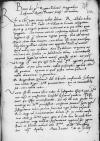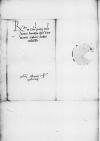Letter #2712
Bona Sforza to Ioannes DANTISCUSWarsaw, 1544-04-07
| received Heilsberg (Lidzbark Warmiński), 1544-04-12 Manuscript sources:
| ||||
Text & apparatus & commentary Plain text Text & commentary Text & apparatus
Reverendo in Christo Patri, domino
Reverende in Christo Pater, sincere nobis dilecte.
Reddidit nobis servitor Vestrae Paternitatis litteras et telam
in cerata colligatam dixitque, quod singulae portiones continerent in se per ulnas quinquaginta, cum tamen non sit consuetum eiusmodi petias longiores esse quam ulnarum viginti quinque, plus aut minus. Dixit etiam idem servitor eam telam esse nimis pretiosam singulosque illius cubitos uno argenteo tallero venire. Quod nobis non videtur, nam
De burgrabiatu Gdanensi domino
Vanus est ille rumor istic natus de instigatore officii
Bene et feliciter valeat Vestra Paternitas.
Dat(ae) or Dat(um)⌈Dat(ae)Dat(ae) or Dat(um)⌉


 BCz, 3465, p. 292
BCz, 3465, p. 292